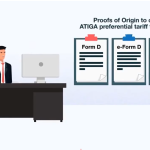Ministry of Posts and Telecommunications (MPTC)
What is a digital signature?
There are different types of digital signatures; this tip focuses on digital signatures for email messages. You may have received emails that have a block of letters and numbers at the bottom of the message. Although it may look like useless text or some kind of error, this information is actually a digital signature. To generate a signature, a mathematical algorithm is used to combine the information in a key with the information in the message. The result is a random-looking string of letters and numbers.
Why would you use one?
Because it is so easy for attackers and viruses to “spoof” email addresses (see Using Caution with Email Attachments for more information), it is sometimes difficult to identify legitimate messages. Authenticity may be especially important for business correspondence—if you are relying on someone to provide or verify information, you want to be sure that the information is coming from the correct source. A signed message also indicates that changes have not been made to the content since it was sent; any changes would cause the signature to break.
How does it work?
Before you can understand how a digital signature works, there are some terms you should know:
- Keys – Keys are used to create digital signatures. For every signature, there is a public key and a private key.
- Private key – The private key is the portion of the key you use to actually sign an email message. The private key is protected by a password, and you should never give your private key to anyone.
- Public key – The public key is the portion of the key that is available to other people. Whether you upload it to a public key ring or send it to someone, this is the key other people can use to check your signature. A list of other people who have signed your key is also included with your public key. You will only be able to see their identities if you already have their public keys on your key ring.
- Key ring – A key ring contains public keys. You have a key ring that contains the keys of people who have sent you their keys or whose keys you have gotten from a public key server. A public key server contains keys of people who have chosen to upload their keys.
- Fingerprint – When confirming a key, you will actually be confirming the unique series of letters and numbers that comprise the fingerprint of the key. The fingerprint is a different series of letters and numbers than the chunk of information that appears at the bottom of a signed email message.
- Key certificates – When you select a key on a key ring, you will usually see the key certificate, which contains information about the key, such as the key owner, the date the key was created, and the date the key will expire.
- “Web of trust” – When someone signs your key, they are confirming that the key actually belongs to you. The more signatures you collect, the stronger your key becomes. If someone sees that your key has been signed by other people that he or she trusts, he or she is more inclined to trust your key. Note: Just because someone else has trusted a key or you find it on a public key ring does not mean you should automatically trust it. You should always verify the fingerprint yourself.
The process for creating, obtaining, and using keys is fairly straightforward:
- Generate a key using software such as PGP, which stands for Pretty Good Privacy, or GnuPG, which stands for GNU Privacy Guard.
- Increase the authenticity of your key by having your key signed by co-workers or other associates who also have keys. In the process of signing your key, they will confirm that the fingerprint on the key you sent them belongs to you. By doing this, they verify your identity and indicate trust in your key.
- Upload your signed key to a public key ring so that if someone gets a message with your signature, they can verify the digital signature.
- Digitally sign your outgoing email messages. Most email clients have a feature to easily add your digital signature to your message.
There are a variety of mechanisms for creating digital signatures, and these mechanisms may operate differently. For example, S/MIME does not add a visible block of letters and numbers within the message, and its digital signatures are verified indirectly using a certificate authority instead of directly with other users in a web of trust. You may just see an icon or note on the message that the signature has been verified. If you get an error about a digital signature, try to contact the sender through a phone call or a separate email address that you know is valid to verify the authenticity of the message.
Authors
Mindi McDowell and Allen Householder



